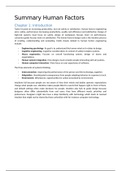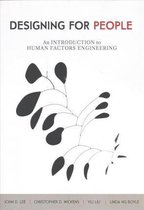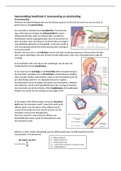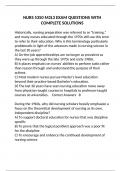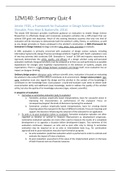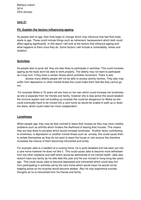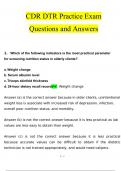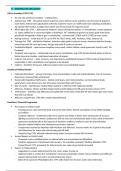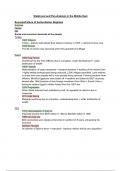Summary Human Factors
Chapter 1: Introduction
Taylor focused on increasing productivity, but not safety or satisfaction. Human factors engineering
aims: safety, performance (increasing productivity, quality and efficiency) and satisfaction. Design of
high-risk systems must focus on safety, design of workplaces focuses more on performance,
consumer goods focuses more on satisfaction. The human factors design cycle is the iterative process
of creating, understanding and evaluating. Fields closely related to human factors engineering
include:
- Engineering psychology. Its goal is to understand the human mind as it relates to design.
- Cognitive engineering. Cognitive considerations in context of safety/complex systems.
- Macro ergonomics. Focuses on overall functioning system, design of teams and
organizations.
- Human-system integration. How designs must consider people interacting with all systems.
- Human-computer interaction. More focus on user experience of software.
The three elements of systems thinking:
- Interconnection. Improving the performance of the person and the technology, together.
- Adaptation. Unanticipated consequences form people adapting behavior in response to tech.
- Environment. Affordances: opportunities for action presented by environment.
Intuitions fail because people are not aware of how their minds and bodies operate: expectations
change what people see, attention makes people blind to events that happen right in front of them,
and default settings often make decisions for people. Intuition also fails to guide design because
designers often differ substantially from end users: they have different needs, priorities and
preferences. Designers might also have a deep familiarity with technology which leads to learned
intuition that might not be shared by those unfamiliar with for instance computer technology.
,Chapter 2: Design methods
Generally design processes include iterative stages that reflect:
- Understanding the user’s needs.
- Creating a product or system.
- Evaluating how well the design meets user’s needs.
The Vee process is often used in large, high-risk systems where sequential development is possible
and verification, validation and documentation is critical. The Vee shape start with a broad system
description and design requirements, which are decomposed into detailed requirements. The Plan-
Do-Check-Act (PCDA) cycle is commonly used to enhance workplace efficiency and production
quality. The steps are trivial, the cycle reflects the scientific management approach by Taylor. The
Scrum process is more typical of consumer software products where an iterative and incremental
approach is needed to resolve uncertainty in design requirements. Vee process focuses on
methodical implementation, PCDA guides incremental improvement and Scrum focuses on fast
iteration. In some cases a hybrid approach of these three is necessary.
Human centered design process has three stages: Understand users, Create prototype, Evaluate
prototype. Heuristic evaluation is quick. Usability tests help understand user’s needs, takes longer,
usually iterative. Questions to be asked before design solutions are created in a task analysis: who
are the users? Why do they need it? What are their preferences? What are the environmental
conditions? What is the physical and organizational context? What major functions must be fulfilled?
When must tasks occur, in what order and how long?
Task analysis is a way of systematically describing human interaction with a system to understand
how to match the demands of the system to human capabilities. It has the following steps;
- Define purpose and identify required data. Typically four types of information are collected:
o Hierarchical relationships. What, why and how tasks are performed.
o Information flow. Who performs the task, with what indications and which feedback.
o Sequence and timing. When, in what order and how long tasks take to perform.
o Location and environmental context. Where and under what physical and social
conditions tasks are performed.
- Collect task data. Goal is to see through users eyes. Task data collection techniques include:
o Observations and questions during use.
o Retrospective (talk about experience) and prospective (talk about how you would use
it) verbal protocol analysis.
o Unstructured and structured interviews. Asking the user to describe their tasks.
o Surveys and questionnaires. Affirm information accuracy, determine frequency,
identify preferences or biases.
o Automatic data recording. Detailed and objective, but lacks purpose behind actions.
- Interpret task data. Some of the most common ways to organize task data:
o Task hierarchy. Goal, task, subtask decomposition. Hierarchy diagram captures
cognitive groupings.
o Task flow. Control decisions regarding the flow form one task to another. Activity
diagrams build on flow charts and show tasks performed concurrently.
, o Task sequence. Task duration and sequence, also communication between system
components. Sequence diagram shows the order and duration of tasks for each
object and person in the system.
- Innovate from task data. The focus on task details needs to be placed in broader user
experience and then linked so design solutions.
o User identification and persona development. Describes most important user
populations. A persona is a hypothetical person developed through interviews and
observations with real people.
o Scenarios, user journeys an use cases. Stories about personas in particular context.
o Environment and context analysis. Describes where tasks, scenarios and personae
live.
o Workload analysis. Considers whether the system is going to place excessive mental
or physical demands on the user.
o Safety and hazard analysis.
o Function allocation analysis. Distribution of tasks between human and technology.
Some general design heuristics include: Create useful innovation, attend to details, simplify, honest
and understandable, provide flexibility, consistency, anticipate needs, minimize memory demands
and lastly consider adaptation.
Design heuristics provide quick input whether design is consistent with human capabilities. Design
patterns are solutions to commonly occurring (usually software) design problems, they fit
consistency. Identifying system requirements is an extension of the task analysis to specify: Overall
objectives of the system, performance requirements and features, design constraints.
Quality function deployment (QFD analysis) ensures design specifications meet user needs and
avoids adding features people do not want. It uses a decision matrix with weights to reflect
importance and ratings how well each feature serves each objective. The sum of weight*rating
serves as an indication.
Advantages of (paper) prototypes, wireframes and mockups:
- Paper prototypes help understand user needs and if early design meets those needs.
- Wireframes communicate and document ideas for the design.
- Mockups make ideas concrete to stakeholders and sponsors.
- Prototypes support heuristic evaluation.
- Prototypes support evaluation by giving users something to react to and use.
, Chapter 3: Evaluation methods (until 3.2.2)
Formative evaluations are evaluation methods that serve as the first step of the next iteration of the
design, they help understand how people use a system, they tend to rely on qualitative measures.
Evaluation methods that serve as the final step are termed summative evaluations, they are used to
assess whether design requirements have been met, they tend to rely on quantitative measures.
Distinctions between these evaluations can be described by main purposes of evaluation:
- Understand how to improve.
- Diagnose problem with prototypes.
- Verify.
Purpose Data used Evaluation methods
Understand Qualitative Open-ended survey
Quantitative Task analysis
Diagnose Qualitative Heuristic evaluation
Cognitive walkthrough
Usability test
Verify Quantitative Field test
A usability study can identify problems quickly whereas a user study takes more time, but is more
thorough. The first step of heuristic evaluation is to select those that apply, the second step is to
carefully inspect the design and identify where it violates the design principles. There should be
multiple evaluators in heuristic evaluation, because there a lots of misses.
Usability testing is a formative evaluation technique, it involves interacting with the system and
measuring user performance as ways to improve the design. Factors that make a system user
friendly:
- Learnability.
- Efficiency.
- Memorability.
Errors. Rather lack of that.
- Satisfaction.

